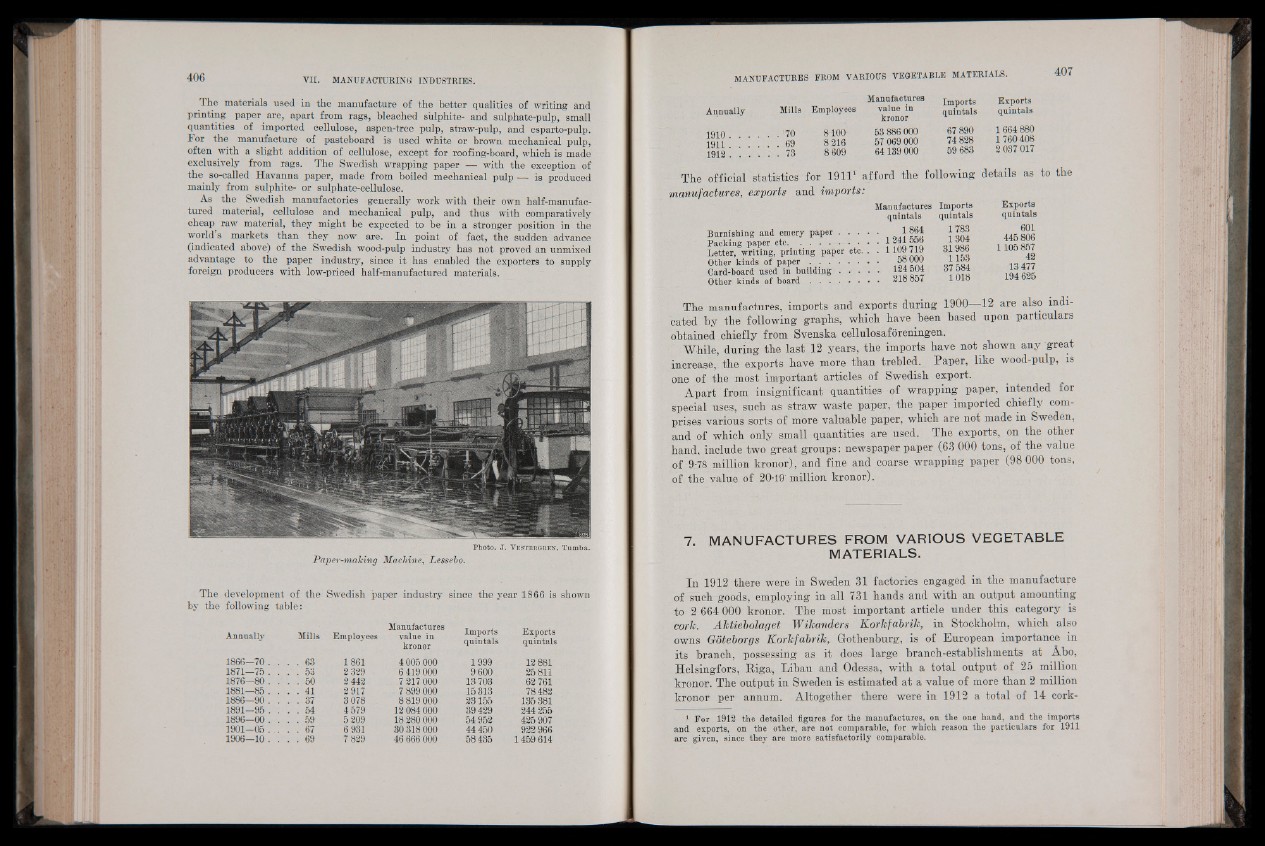
The materials used in the manufacture of the better qualities of writing and
printing paper are, apart from rags, bleached sulphite- and sulphate-pulp, small
quantities of imported cellulose, aspen-tree pulp, straw-pulp, and esparto-pulp.
For the manufacture of pasteboard is used white or brown mechanical pulp,
often with a slight addition of cellulose, except for roofing-board, which is made
exclusively from rags. The Swedish wrapping paper — with the exception of
the so-called Havanna paper, made from boiled mechanical pulp — is produced
mainly from sulphite- or sulphate-cellulose.
As the Swedish manufactories generally work with their own half-manufactured
material, cellulose and mechanical pulp, and thus with comparatively
cheap raw material, they might be expected to be in a stronger position in the
world s markets than they now are. In point of fact, the sudden advance
(indicated above) of the Swedish wood-pulp industry has not proved an unmixed
advantage to the paper industry, since it has enabled the exporters to supply
foreign producers with low-priced half-manufactured materials.
Photo. J. V e s t e r g r e n , Tumba.
Paper-making Machine, Lessebo.
The development of the Swedish paper industry since the year 1866 is shown
by th e following table :
Annually Mills Employees
Manufactures
value in
kronor
Imports
quintals
Exports
quintals
1866—70 . . . . 63 1861 4005 000 1999 12 881
1871—75 . . . . 53 2 329 6 419 000 9 600 25 811
1876—80 . . . . 50 2 442 7 217 000 13 703 62 761
1881—85 . . . . 41 2 917 7 899 000 15313 78482
1886—90 . . . . 37 3 078 8819000 23155 135 381
1891—95 . . . . 54 4 579 12 084 000 39 429 244 255
1896—00 . . . . 59 5 209 18280000 54 952 425 907
1901—05 67 6 931 30 318 000 44 450 922 966
1906—10 . . . . 69 7 829 46 666 000 58 435 1459 614
Manufactures Imports Exports
Annually Mills Employees value in quintals quintals
kronor
1910 70 8 100- 53 886 000 67 890 1 664 880
1 q n «9 8 216 57 069 000 74 828 1 760 408
1912". ! ! 73 8609 64139 000 59 683 2 037 017
The official statistics for 19111 afford the following details as to the
■manufactures, exports and imports:
Manufactures Imports Exports
quintals quintals quintals W paper::::: Wm 130! 1111 Letter, writing, printing paper etc. . . 1109 719 31 986 1105 85
Other kinds of paper . .................... 58 000 *153
Card-board used in b u ild in g ................ 124 504 37 584 13 7
Other kinds of b o a r d ............................ 218 857 1 018 in i «¿0
The manufactures, imports and exports during 1900—12 are also indicated
by the following graphs, which have been based upon particulars
obtained chiefly from Svenska cellulosaforeningen.
While, during the last 12 years, the imports have not shown any great
increase, the exports have more than trebled. Paper, like wood-pulp, is
one of the most important articles of Swedish export.
Apart from insignificant quantities of wrapping paper, intended for
special uses, such as straw waste paper, the paper imported chiefly comprises
various sorts of more valuable paper, which are not made in Sweden,
and of which only small quantities are used. The exports, on the other
hand, include two great groups: newspaper paper (63 000 tons, of the value
of 9:78 million kronor), and fine and coarse wrapping paper (98 000 tons,
of the value of 20-19 million kronor).
7. MANUFACTURES FROM VARIOUS VEGETABLE
MATERIALS.
In 1912 there were in Sweden 31 factories engaged in the manufacture
of such goods, employing in all 731 hands and with an output amounting
to 2 664 000 kronor. The most important article under this category is
cork. Aktiebolaget Wikanders Korkfabrik, in Stockholm, which also
owns Goteborgs Korkfabrik, Gothenburg, is of European importance in
its branch, possessing as it does large branch-establishments at Abo,
Helsingfors, Riga, Libau and Odessa, with a total output of 25 million
kronor. The output in Sweden is estimated at a value of more than 2 million
kronor per annum. Altogether there were in 1912 a total of 14 cork-
1 For 1912 the detailed fignres for the manufactures, on the one hand, and the imports
and exports, on the other, are not comparable, for which reason the particulars for 1911
are given, since they are more satisfactorily comparable.